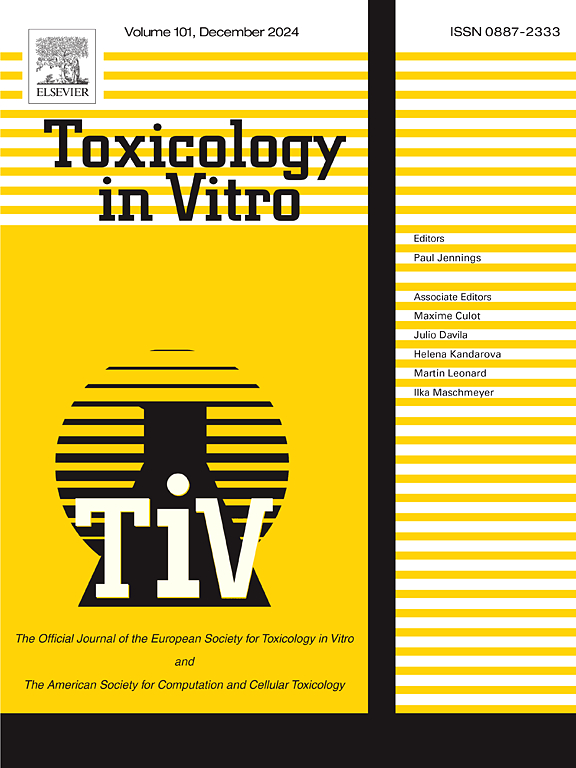The effects of flavored vaped e-liquids on cultured human macrophages derived from the central and peripheral nervous systems
IF 2.6
3区 医学
Q3 TOXICOLOGY
引用次数: 0
Abstract
The use of the electronic cigarette (e-cig) to consume an aerosol is referred to as “vaping” and has become the most popular method for nicotine consumption amongst youth and many adults worldwide. This popularity is at least partially attributable to the availability of 1000s of distinctly flavored e-liquids. At present, a large number of studies have evaluated the potential negative effects of e-cig use in relation to pulmonary disease. These studies have demonstrated that vaping can lead to immune activation and cell death but typically include only epithelial cell line studies. At present, significantly less is known about the effects of vaped e-liquids on the central nervous system (CNS) and peripheral nervous system (PNS). To investigate this gap, we utilized the human macrophage cell lines KG-1 (PNS-resident macrophages) and DBTRG-05MG (CNS-resident macrophages) and examined their exposure to vaped e-liquids. To carry out these investigations, measurements of: cell viability, expression of inflammatory cytokines, phagocytosis and reactive oxygen species (ROS) were employed. Our findings illustrate that when exposed to e-liquid, and especially flavored e-liquids, both peripheral and central macrophage cell lines decrease in cell viability, showcase an upregulated level of expression of pro-inflammatory cytokines, a diminished level of phagocytic activity and an overall increased level of reactive oxidative species. Thus, our study further indicates that the use of the e-cig can cause phenotype and immune disruptions within both the CNS and PNS.
调味电子烟液体对培养的来自中枢和周围神经系统的人巨噬细胞的影响。
使用电子烟(e- cigg)吸气溶胶被称为“vaping”,这已经成为世界上年轻人和许多成年人最流行的尼古丁消费方式。这种受欢迎程度至少部分归因于数千种不同口味的电子烟液体的可用性。目前,大量的研究已经评估了电子烟使用对肺部疾病的潜在负面影响。这些研究表明,电子烟可以导致免疫激活和细胞死亡,但通常只包括上皮细胞系的研究。目前,人们对电子烟液体对中枢神经系统(CNS)和周围神经系统(PNS)的影响知之甚少。为了研究这一差异,我们利用人巨噬细胞系KG-1 (pns驻留巨噬细胞)和DBTRG-05MG (cns驻留巨噬细胞),研究了它们对电子烟液体的暴露情况。为了进行这些研究,采用了细胞活力、炎症细胞因子表达、吞噬和活性氧(ROS)的测量。我们的研究结果表明,当暴露于电子液体,特别是调味电子液体时,外周和中央巨噬细胞系的细胞活力下降,表现出促炎细胞因子表达水平上调,吞噬活性水平降低,反应性氧化物质总体水平增加。因此,我们的研究进一步表明,电子烟的使用会导致CNS和PNS内的表型和免疫破坏。
本文章由计算机程序翻译,如有差异,请以英文原文为准。
求助全文
约1分钟内获得全文
求助全文
来源期刊

Toxicology in Vitro
医学-毒理学
CiteScore
6.50
自引率
3.10%
发文量
181
审稿时长
65 days
期刊介绍:
Toxicology in Vitro publishes original research papers and reviews on the application and use of in vitro systems for assessing or predicting the toxic effects of chemicals and elucidating their mechanisms of action. These in vitro techniques include utilizing cell or tissue cultures, isolated cells, tissue slices, subcellular fractions, transgenic cell cultures, and cells from transgenic organisms, as well as in silico modelling. The Journal will focus on investigations that involve the development and validation of new in vitro methods, e.g. for prediction of toxic effects based on traditional and in silico modelling; on the use of methods in high-throughput toxicology and pharmacology; elucidation of mechanisms of toxic action; the application of genomics, transcriptomics and proteomics in toxicology, as well as on comparative studies that characterise the relationship between in vitro and in vivo findings. The Journal strongly encourages the submission of manuscripts that focus on the development of in vitro methods, their practical applications and regulatory use (e.g. in the areas of food components cosmetics, pharmaceuticals, pesticides, and industrial chemicals). Toxicology in Vitro discourages papers that record reporting on toxicological effects from materials, such as plant extracts or herbal medicines, that have not been chemically characterized.
 求助内容:
求助内容: 应助结果提醒方式:
应助结果提醒方式:


